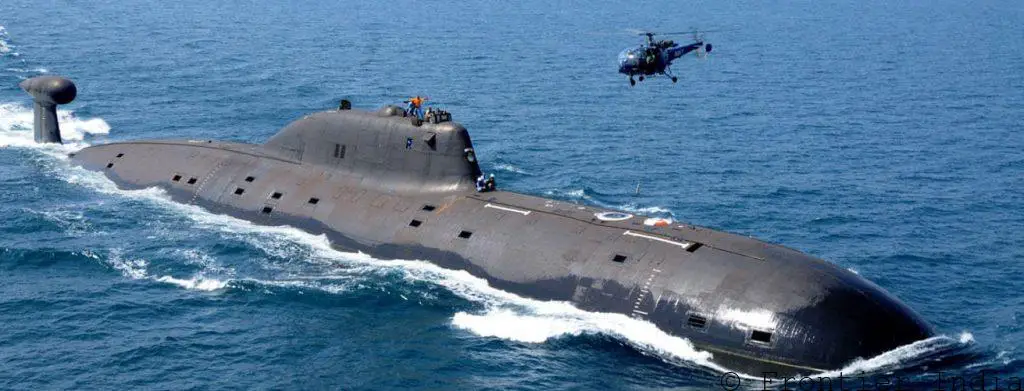Russian Nerpa submarine (K-152) renamed INS Chakra, after its induction into the Indian Navy in 2012 on a ten-year lease, was returned back to Russia prematurely. Some social media users on June 4 were excited to report the sighting of the Project 971 Akula Class submarine in the Singapore Strait flanked by a Russian Navy Udaloy-class ASW destroyer ( Admiral Tributs, Project 1155), a salvage tug Kalar (both had a stop in Singapore for water and fuel before escorting as per Interfax) and a Russian A330 Air Force tanker flying overhead. Users also spotted an Indian Navy Delhi-class DDG escorting the submarine in the Malacca Straits. The submarine was transiting with its automatic identification system (AIS) active.
The pattern of surfacing at Malacca Straits followed was similar to the return of Charlie Class Submarine (K-43), the former INS Chakra. Dived passage in Malacca, Singapore straits and the Southern part of the South China Sea is not possible due to insufficient depths. Even the Chinese nuclear submarines have to travel on the surface before diving in Malacca Straits to reach the Indian side.
The Reason
The reason for the return as per TASS is the explosion of a high-pressure air cylinder on the Chakra submarine… (which) occurred in the spring of 2020.” The high-pressure air cylinder was located between the two hulls. In addition to the damage to the hulls, the explosion also damaged “electronic weapons and hydro-acoustic equipment”. As per a source from the Russian Military-Industrial complex, “after the emergency, Indian technical specialists completed the repair of both hulls of the submarine,” following which it was sent to Russia. It also said that there was one causality from the Indian side.
But later Tass deleted the article, “The reason for the return of the submarine” Chakra “to Russia from India was an explosion on board – a source”, issued at 03:00:01 and 03:00:30 Moscow time, ARE CANCELED as issued erroneously. TASS apologizes to its subscribers and readers.”
But the clue is enough to understand the reason for the return of the submarine and it is conventional.

Why is the High-Pressure air cylinder important?
In a submarine, the HP air is used to blow the water out of the ballast tanks while surfacing.
In conventional submarines, only the emergency group is blown in a planned surfacing to conserve HP air. That brings the boat to semi surfaced state. Then the other tanks are blown by diesel exhaust. In emergency surfacing all the groups are blown by HP air. This is conventional knowledge. Even in the nuclear submarines, during the planned surfacing the emergency group is blown usually at shallow Periscope depth. On surfacing the other groups are blown. The air consumed is much less because it works against lesser external pressure.
Usually in submarine construction, for greater redundancy, HP air groups are divided into groups. In the case of emergencies all can be on the common grid. Similarly, ballast tanks are also divided into groups. This is a construction principle for safety and redundancy.
Why was INS Chakra returned?
From the above, one can understand that the HP air bottle is the lifeline of a submarine. The most likely cause of the explosion of the HP air bottle could be a material failure. In respect of HP Air bottle, as per international standards, such systems are tested to 1.5 times their working pressure, hence, the most likely cause for an HP air bottle giving way is a material failure. Such an episode raises genuine doubts about the system. It is likely that the Indian Navy must have prematurely terminated the lease. Combine this incident with the previous incident of the Submarine Sonar getting damaged and was repaired by the Indian Navy. It raises the question of liability if a more serious accident happens.
